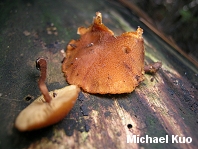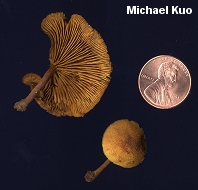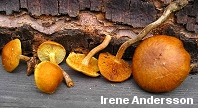| Major Groups > Gilled Mushrooms > Dark-Spored > Gymnopilus > Gymnopilus sapineus |

|
Gymnopilus sapineus [ Basidiomycetes > Agaricales > by Michael Kuo Gymnopilus sapineus is a small species of Gymnopilus found on the wood of conifers. It features a smooth or scaly cap that ranges from yellowish to tawny or reddish brown, a very fragile and quickly lost cortina-like partial veil, a skinny stem that darkens with handling or in age, and spores 6.5-10 µ long. My definition of the species may not completely match your field guide's definition, since I have combined Gymnopilus sapineus with Gymnopilus penetrans. These species have been so thoroughly confused by so many authors over the past 200 years that I have decided to return almost to Square One, with Elias Fries's 1821 account; see the discussion below if you are interested. Description: Ecology: Saprobic on the dead wood of conifers (especially pines); growing alone, gregariously, or in small clusters; summer and fall; widely distributed in North America. Cap: 2-8 cm; convex or nearly flat, sometimes slightly bell-shaped; dry; smooth, finely hairy, or decidedly but minutely scaly; yellowish to tawny or reddish brown. Gills: Attached to the stem; close; yellow, yellowish, or whitish at first, developing rusty brown spots and eventually becoming rusty brown overall. Stem: 3-7 cm long; under 1 cm thick; more or less equal; smooth or finely hairy; colored like the cap, but paler; usually darkening to brown from the base up with age; with whitish to yellowish basal mycelium. Flesh: Whitish or pale yellow. Odor and Taste: Taste bitter or, more rarely, mild; odor not distinctive. Spore Print: Rusty brown to orange-brown. Chemical Reactions: KOH dark red, then black on cap surface. Microscopic Features: Spores 6.5-10 x 4-5.5 µ; warty; elliptical; dextrinoid. Pleurocystidia and cheilocystidia both present (but the former scarcely projecting beyond the basidia); variously shaped. Caulocystidia present. REFERENCES: (Fries, 1821) Maire, 1933. (Saccardo, 1887; Hesler, 1969; Smith, Smith & Weber, 1979; Arora, 1986; Phillips, 1991/2005; Lincoff, 1992; Barron, 1999; Guzmán-Dávalos et al., 2003; McNeil, 2006; Miller & Miller, 2006.) Herb. Kuo 05099503, 11050401. Your Gymnopilus source, whether it is a field guide or a more technical publication, may tell you that Gymnopilus sapineus has a scaly cap, while the cap of Gymnopilus penetrans is finely hairy, but not scaly. Or your source may say the opposite. I found this conflict irritating enough that I followed it all the way back to its source--and the culprit appears to be old Elias Fries, whose 1821 description of Agaricus penetrans is worded a little confusingly. But before I discuss his description, it should be noted that Fries saw Agaricus penetrans as a mere form of Agaricus sapineus--not as a separate species. Though he named Agaricus penetrans seven years earlier in 1815, in 1821 he described Agaricus sapineus as new and called his previous species, Agaricus penetrans, a form of the new species. Fries compounded the confusion with the following description of the cap surface in the penetrans form of Agaricus sapineus: Pileus . . . proprie laevis, sed saepe rimosus diffracto-squamosus! [italics and exclamation point in Fries] My high school Latin and a Latin dictionary render this in English as: Cap . . . characteristically smooth, but frequently rimose shattered-scaly! Yes, there's probably a better translation for diffracto than "shattered," but the point is that Fries's italics and exclamation point have attracted all the attention from some later mycologists who felt the two taxa should again be split into separate species--and the non-italicized part of the description, which calls the cap "characteristically smooth," has been ignored. Fade back to the present . . . and we have this from a DNA study that included four Gymnopilus penetrans specimens and two specimens of Gymnopilus sapineus (Guzmán-Dávalos et al., 2003): Gymnopilus penetrans and G. sapineus are very similar to each other both macro- and micromorphologically and occur in similar habitats (i.e., on branches and logs in coniferous or temperate forests). The primary differences between these two species are in the ornamentation of the pileus, being fibrillose and lacking pileocystidia in the former and squamulose with poorly differentiated pileocystidia in the latter. They are grouped together [in the study's results] with a 100% bootstrap and posterior probability. Further studies are needed to confirm if they are conspecific or separate species. There you have it. More, I'm sure, than you ever wanted to know about Gymnopilus sapineus and Gymnopilus penetrans . . . but if you have been struggling to figure out which of the two names best matches your collection, I hope I have convinced you that you have better things to do. This website contains no information about the edibility or toxicity of mushrooms. |
© MushroomExpert.Com |
|
Cite this page as: Kuo, M. (2007, February). Gymnopilus sapineus. Retrieved from the MushroomExpert.Com Web site: http://www.mushroomexpert.com/gymnopilus_sapineus.html |


